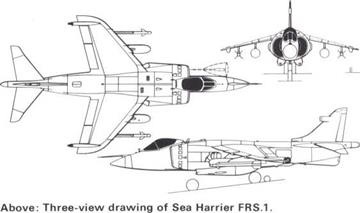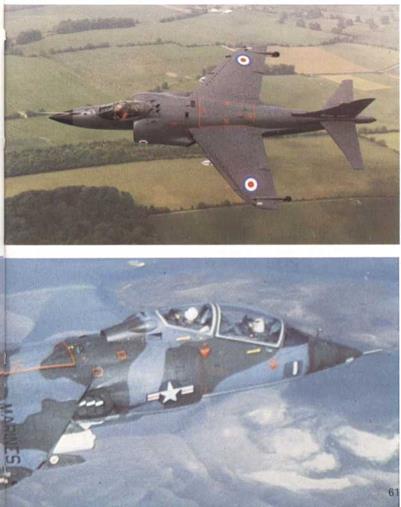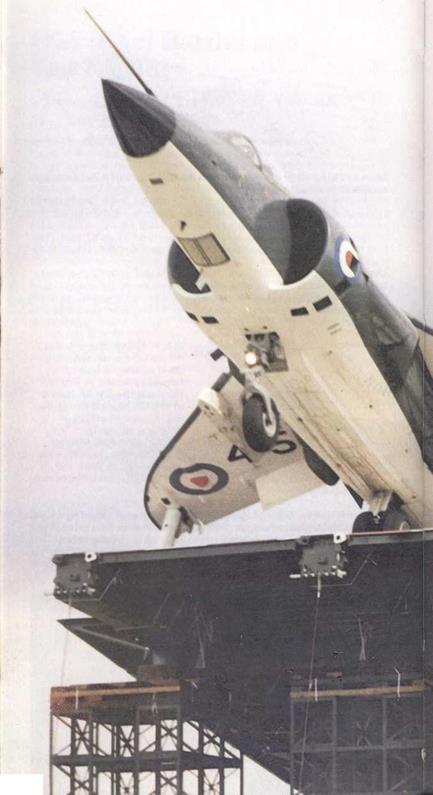HSA (BAe) Harrier and Sea Harrier
Harrier GR.3 and T.4, AV-8A, TAV-8A and Sea Harrier FRS.1
Origin: Hawker Siddeley Aviation (now British Aerospace), UK,
Type: Single-seat tactical attack and reconnaissance: (T.4, TAV) dual trainer or special missions: (Sea Harrier) single-seat ship-based multi-role. Engine: One 21,500lb (9752kg) thrust Rolls-Royce Pegasus 103 two-shaft vectored-thrust turbofan (US designation F402): (Sea H, Pegasus 104). Dimensions: Span 25ft 3in (7-7m), (with bolt-on tips, 29ft 8in): length 45ft 6in (13’87m), (laser nose, 47ft 2in: two-seat trainers. 55ft 9iin; Sea Harrier, 48ft): height 11ft 3in (3’43m) (two-seat, 13ft 8in),
Weights: Empty (GR.1) 1 2.2001b (5533kg): (Sea H) 13,0001b (5897kg): (T) 13,6001b (6168kg): maximum (non-VTOL) 26,000lb (11,793kg), Performance: Maximum speed,737mph (1186km/h, Mach 0 972) at low level: maximum dive Mach number, T3: initial climb (VTQL weight) 50,000ft (1 5,240m)/min: service ceiling, over 50,000ft (15,240m): tactical radius on strike mission without drop tanks (hi-lo-hi) 260 miles (418km): ferry range 2,070 miles (3330km).
Armament: All external, with many options. Under-fuselage strakes both replaceable by pod containing one 30mm Aden or similar gun, with 150 rounds. Five or seven stores pylons, centre and two inboard each rated at 2,000lb (907kg), outers at 650lb (295kg) and tips (if used) at 220lb (100kg) for Sidewinder or similar. Normal load 5,3001b (2400kg), but 8,0001b (3630kg) has been flown.
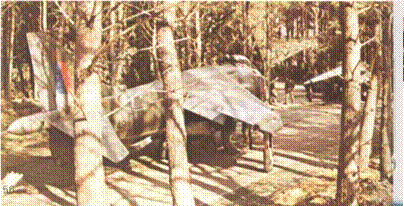 |
Below: Unlike every other combat aeroplane in Western Europe the Harrier could escape the devastating missile attack on airfields that would begin any future war in Europe. Unfortunately most Harriers are usually at risk on airfields, instead of being safely dispersed into the countryside as are these Harrier FGA.3 single – seaters pictured during a special exercise in off-base operation.
Above: Three-view drawing of Harrier GR.3 with FR probe, laser nose and (dotted) ferry tips.
History: First hover (P.1127) 21 October 1960: first flight (P.1127) 13 March 1961: first flight (Kestrel) 13 February 1964: (development Harrier) 31 August 1966: (Harrier GR.1) 28 December 1967: (T.2) 24 April 1969: (Sea Harrier FRS.1) 20 August 1 978: squadron service (GR.1) 1 April 1969: (Sea Harrier) late 1979.
Users: Spain (Navy, AV-8A). UK (RAF, Royal Navy), USA (Marine Corps). Development: In the 1950s the realisation that the thrust/weight ratio of the gas turbine made possible a new class of high-speed jets having VTOL (vertical takeoff and landing) capability led to a rash of unconventional
continued ►
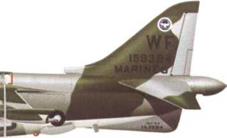
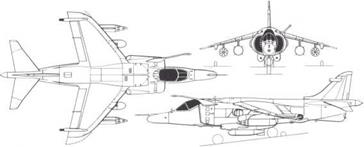 |
Left: Though they are basic attack platforms without most of the sophisticated systems carried by RAF Harriers, the AV-8A Harrier of the US Marine Corps had the important effect of showing an insular Washington that foreign equipment could offer new capabilities. In turn, the Marines explored Harriers as fighters.
Below: A Harrier GR.3 of the RAF salvoes rockets in a firing pass against a ground target. This particular example is armed with four Matra 155 pods, each containing 19 SIMEB rockets of 68mm calibre. They are reasonably effective against hardened targets such as armour, though probably not as lethal as the BL.755 cluster bomb which is an alternative now available.
![]()
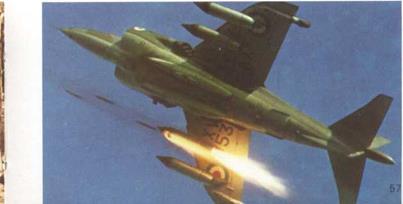
|
|
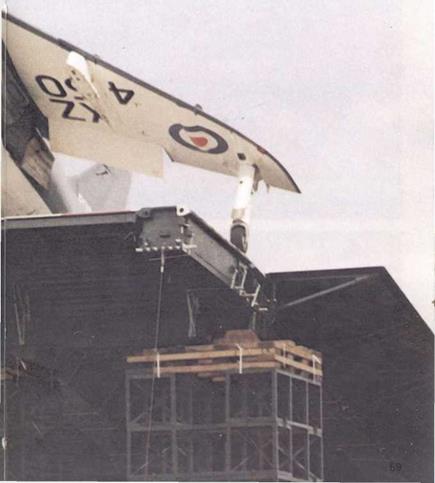
By using an upward-curving ‘ski jump’ a Sea Harrier (or any other STOL aircraft) can carry much heavier loads with complete pilot safety, especially in operations from surface ships. This ski jump was built by Fairey Engineering from existing Medium Girder Bridge components and used at the 1978 Farnborough Air Show for Harriers and (as shown here) the first Sea Harrier FRS.1. Today the Sea Harrier is in service with the Royal IMavy and will be deployed aboard the lnvincible-cass light multi-role carriers. Invincible has a 7° ramp, while her two sisters. Illustrious and Ark Royal, have 15° ramps and a relocated Sea Dart launcher.
prototypes and research machines. Only one has led to a useful combat aircraft. It was the P.1127, designed by Camm’s team in 1957-59 around a unique engine, planned at Bristol by Stanley Hooker, in which the fan and core flows are discharged through four nozzles which, by means of chain drives from a single pneumatic motor, can be swivelled to point downwards, to lift the aircraft, or point to the rear, for propulsion. Gradually the P.1127 was transformed into the Kestrel, which equipped a UK/USA/German evaluation squadron in 1965. This was further developed into the Harrier (the much bigger, Mach 2, P.1154 for the RAF and RN having been cancelled in 1 965). Powered by a Pegasus 101 rated at 1 9,000lb, the GR.1 was capable of flying useful combinations of fuel and stores out of any hastily prepared site and did more than any other aircraft to explore the advantages and problems of operational deployment of combat aircraft well away from any airfield. Numerous flights were made from a wide variety of naval vessels and record flights were made from the centre of London to the centre of New York and vice versa. The GR.1 A had the 20,000lb Mk 102 engine and at this thrust the Harrier was adopted as the AV-8A by the US Marine Corps in both beach assault and defensive roles. All RAF and USMC aircraft have been re-engined with the Pegasus 103,.giving a payload/range performance adequate for a wide spectrum of missions, many of which cannot be flown by any other aircraft. Using VIFF (vectoring in forward flight) the Harrier can fly "impossible" manoeuvres and has proved itself an extremely tricky customer in a dogfight. This is not its main mission, however, and the RAF Harrier GR.3 (92 built) is primarily a tactical attack platform with Ferranti INAS (inertial nav/attack system) and laser ranger. The USMC AV-8A (112, plus six for Spain named Matador) does not have either of these equipments but carries Sidewinder air/air missiles. Including two-seaters, production by 1 977 amounted to 231. In Britain the main effort is completing development of the redesigned Sea Harrier, which should fly in 1977. The Royal Navy will deploy 24 from throughdeck cruisers and possibly other ships, and several other navies are discussing possible orders. The Sea Harrier has a completely new nose, with raised cockpit. Blue Fox’ radar, much enhanced systems and equipment and weapons for surface attack, reconnaissance, anti-submarine warfare and air combat. Since 1975 talks have been held with China, which is interested in buying a large number of Harriers. The next-generation AV-8B is discussed under McDonnell Douglas.
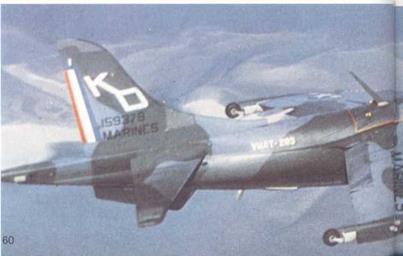 |
Below: A fine portrait of a British Aerospace TAV-8A Harrier dual-control trainer (with full combat capability) of the US Marine Corps, serving with VMAT-203, which handles the important task of converting pilots forVMA-231, -513 and -542.
|
